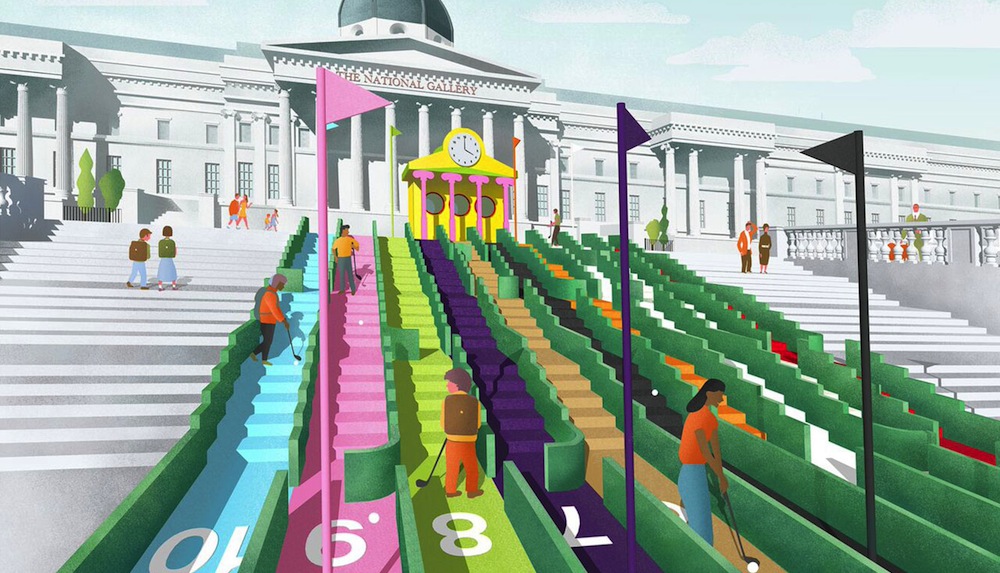The London Design Festival launched a crowdfunding campaign to raise money for one of the craziest mini-golf courses ever made.
The plan is to turn London’s Trafalgar Square into a colorful course this September. Notable designers, including Tom Dixon, Mark Wallinger, and the late Zaha Hadid, each get to create a hole of their own.
Eight holes have been designed for the mini-golf (known in the UK as "crazy golf") course, and they all feature much more than a windmill and a turf incline. Dixon’s hole integrates pneumatic tubes; players must navigate Wallinger’s circular maze; and Hadid designed a curvy, dual-level hole that traces the shadow of the square’s Nelson’s Column. The entries are bright, creative, and, to many putt-putt golfers across the universe, at least a quadruple bogey.
Paul Smith is the project’s visionary. The architect has held other events at Trafalgar Square over the years, including life-size chess and a robot show. Smith’s hole calls for a set of 10 multicolored stairways. The other designers who took part in the project are Camille Walala, Atelier Bow-Wow, HAT Projects, NEON, and Ordinary Architecture, the latter of which envisioned a hole where a player hits their ball into a large pigeon and watches it roll through its digestive tracks.
The project’s goal is to amuse both adults and children, and teach the public about the future of design.
The course “will attract a wide, public audience, and inspire the next generation of creatives,” as its Kickstarter puts it. “Thousands will be able to play the course, and millions more will watch and enjoy this experience, both in the square and through media.”
A little more than $5,000 has been raised thus far. There are still 42 days left to reach the $172,862 goal.
Related Stories
| Feb 14, 2014
The Technology Report 2014: Top tech tools and trends for AEC professionals
In this special five-part report, Building Design+Construction explores how Building Teams throughout the world are utilizing advanced robotics, 3D printers, drones, data-driven design, and breakthroughs in building information modeling to gain efficiencies and create better buildings.
| Feb 14, 2014
Crowdsourced Placemaking: How people will help shape architecture
The rise of mobile devices and social media, coupled with the use of advanced survey tools and interactive mapping apps, has created a powerful conduit through which Building Teams can capture real-time data on the public. For the first time, the masses can have a real say in how the built environment around them is formed—that is, if Building Teams are willing to listen.
| Feb 13, 2014
University officials sound off on net zero energy buildings
As part of its ongoing ZNE buildings research project, Sasaki Associates, in collaboration with Buro Happold, surveyed some 500 campus designers and representatives on the top challenges and opportunities for achieving net-zero energy performance on university and college campuses.
| Feb 13, 2014
3 keys to designing freestanding emergency departments
Having physically disassociated from a central hospital, FEDs must overcome the particular challenges associated with a satellite location, namely a lack of awareness, appeal, and credibility. Gresham, Smith & Partners' Kristin Herman-Druc offers three keys to success.
| Feb 13, 2014
Why you should start with a builder
They say the best way to eat an elephant is one bite at a time. Expanding your building or constructing a new structure for your business, church, or school isn’t all that different. Attacking it is best done in small, deliberate pieces.
| Feb 13, 2014
Related Companies, LargaVista partner to develop mixed-use tower in SoHo
The site is located at the gateway to the booming SoHo retail market, where Class A office space is scarce yet highly in demand.
| Feb 12, 2014
First Look: Futuristic Silicon Valley campus designed to draw tech startups
The curved campus will consist of four different buildings, one exclusively for amenities like a coffee bar, bike shop, and bank.
| Feb 12, 2014
IIT's College of Architecture launches the Mies Crown Hall Americas Prize
Awarded biennially with a $50,000 prize, the program will recognize the most distinguished architectural works built on the North and South American continents in the preceding two years.
| Feb 11, 2014
Adobe Photoshop update features new 3D printing capabilities
Available as part of an update to Photoshop Creative Cloud, the tool enables users to easily and reliably build, refine, preview, prepare, and print 3D designs.
| Feb 10, 2014
Proposed parking garage will sandwich vehicles between housing and retail space
Architecture firm Brisac Gonzalez says that the design "will introduce different activities after parking hours."

















